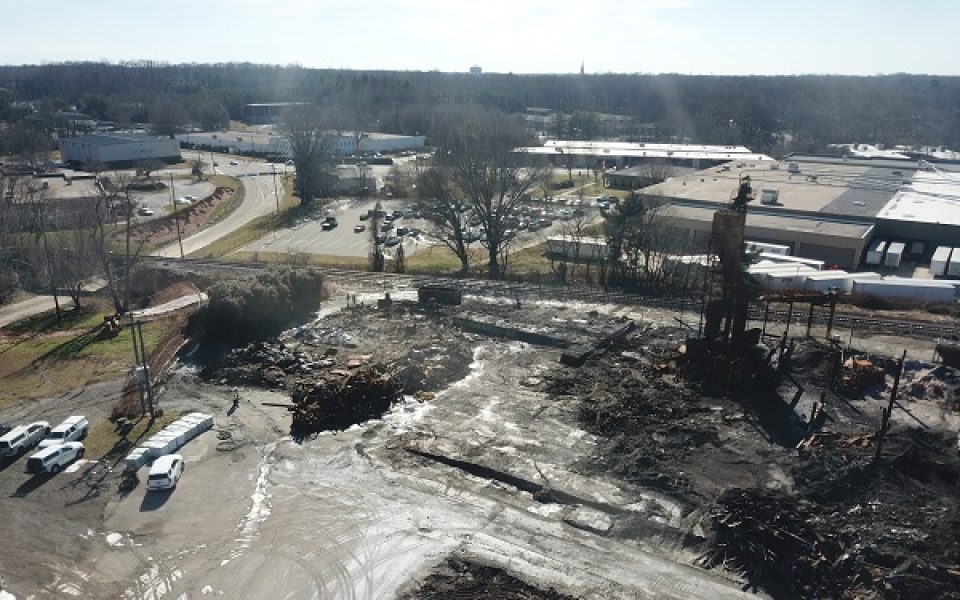Featured photo: The Weaver Fertilizer plant was destroyed by the blaze. (Photo: NC DOL)
This story was originally published by NC Newsline, story by Lisa Sorg
Nearly two years after a catastrophic fire at the Weaver Fertilizer plant in Winston-Salem, contaminated groundwater at the site has “likely migrated offsite to the west and north,” state records show, and “more groundwater investigation is necessary.”
The groundwater beneath the property at 4440 N. Cherry St., contains high levels of at least 15 contaminants, including arsenic, ammonia, xylene and nitrate.
Groundwater at a second property on Brownsboro Road, where the company stored chemicals used in making fertilizer, is also heavily contaminated.
The neighborhoods near the sites are connected to the city’s water supply, but contamination from previous spills and releases has entered nearby Monarcas Creek.
An environmental contractor hired by Weaver Fertilizer provided a second round of findings to the N.C. Department of Environmental Quality earlier this fall as part of a planned cleanup of the properties.
On the evening of Jan. 31, 2022, a fire ignited at the 80-year-old plant, where 600 tons of potentially explosive ammonium nitrate were stored. City officials asked more than 6,000 people living within a mile of the plant to evacuate. The blaze burned for four days, Newsline reported at the time.
In addition, there were 4.5 million pounds of 26 other chemicals stored at the plant, according to the facility’s inventory report. This map shows the locations of the contaminated sites and Monarcas Creek. State regulators have found high levels of nitrate, likely from the fertilizer storage shed, in the creek when streamflow is low. (Based map: Montrose Environmental)
The company owners have since removed the charred skeleton of the plant, as well as 11,286 tons of soil, fertilizer and debris that were disposed of at the Hanes Mill landfill in Winston-Salem and the Uwharrie landfill, about 70 miles south, in Mount Gilead.
While elevated levels of carcinogens arsenic and hexavalent chromium were found in shallow soil near the former loading dock and railroad spur, the most significant environmental issue is the groundwater.
Here are the ranges of exceedances above the state’s groundwater standards at the main Cherry Street property:
- Arsenic – 25 to 75 times greater
- Cadmium — 2 to 15 times
- Manganese — 400 times
- Selenium – 3 to 9 times
- Ammonia – 40 to 460 times
- Nitrate – 31 to 62 times
- Barium – 7 times
- Benzene – 2 to 57 times
- Nitrate – between 10 and 60 times
Over the 80-year life of the facility, petroleum tanks leaked other chemicals into groundwater: xylene, ethylbenzene, naphthalene and toluene have all been detected at concentrations well above state standards.
An earthen berm has been built to prevent runoff from leaving the property and discharging into Monarcas Creek. State regulators are concerned that if the berm is damaged, it could allow the contamination to enter Monarcas Creek. “Considering this potential any remediation in this area is suspended” until a collection system for contaminated stormwater is complete.
Parts of the berm could be contaminated as well, and “more assessment may be required to remove hotspots,” state records show.
Groundwater is also highly contaminated at 4020 Brownsboro Road, where the company had been legally storing chemicals in an open-sided shed. Releases of those chemicals contaminated Monarcas Creek, which abuts the property.
Below ground, high levels of chemicals associated with fertilizers, like those at the Cherry Street property, were also detected at Brownsboro Road, in some cases hundreds of times above state standards.
Although the groundwater flows northeast from the property toward Monarcas Creek, environmental contractors have not found contaminants in wells beyond the site. “More studies and sampling are needed to confirm there is no migration offsite,” the contractors told DEQ.
Monarcas Creek runs through Historic Bethabara Park, and flows into Mill Creek. From there, Mill Creek joins Muddy Creek, a tributary of the Yadkin River. The river is the drinking water supply for more than 840,000 people.
NC Newsline is part of States Newsroom, a nonprofit news network supported by grants and a coalition of donors as a 501c(3) public charity. NC Newsline maintains editorial independence. Contact Editor Rob Schofield for questions: [email protected]. Follow NC Newsline on Facebook and Twitter.
Join the First Amendment Society, a membership that goes directly to funding TCB‘s newsroom.
We believe that reporting can save the world.
The TCB First Amendment Society recognizes the vital role of a free, unfettered press with a bundling of local experiences designed to build community, and unique engagements with our newsroom that will help you understand, and shape, local journalism’s critical role in uplifting the people in our cities.
All revenue goes directly into the newsroom as reporters’ salaries and freelance commissions.


Leave a Reply